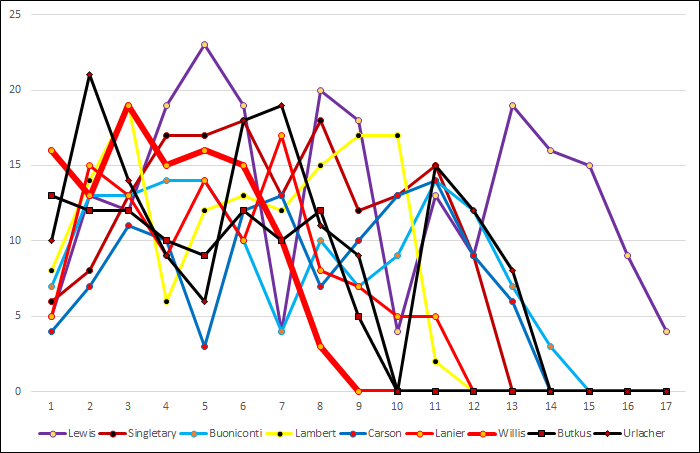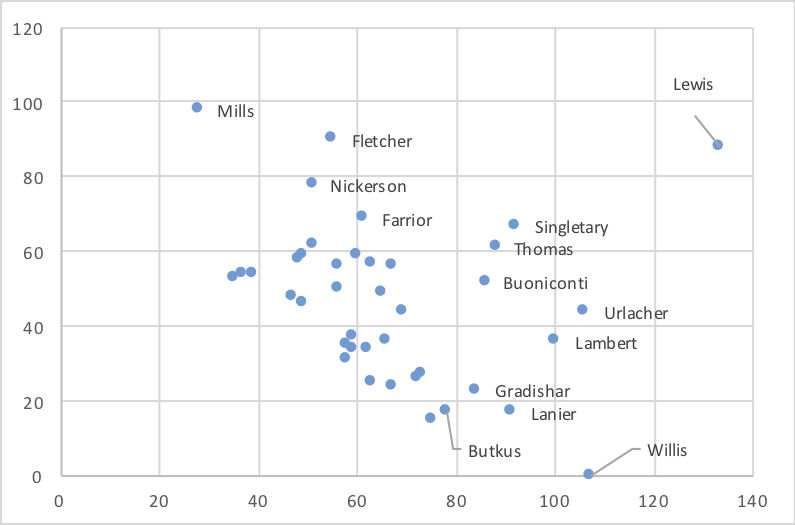Tonight, the 2018 Pro Football Hall of Fame class will be inducted. It’s a great class, with Ray Lewis, Randy Moss, Brian Urlacher, Terrell Owens, and Brian Dawkins as the five modern-era selections.,joined by Jerry Kramer and Robert Brazile from the senior’s committee and Bobby Beathard as the Contributor selection.
Here’s what I wrote about Lewis when he was announced:
You won’t be on an island if you suggest that Lewis is the best inside linebacker in NFL history. Lewis scores well in pretty much every metric possible. When it comes to Approximate Value, what Ray Lewis did was unbelievable. He made 13 Pro Bowls, which is also absurd. The Ravens went on a magical run to win the Super Bowl in his final year, and at the time he retired, he was arguably the best player to retire after winning the Super Bowl.
His Ravens defenses were almost always very good, giving him one of the highest DVOA grades in history. When I looked at the career of Patrick Willis, I compared his AV by year to the (now 8) modern players in the Hall of Fame who primarily played the inside linebacker position. Look at how much of an outlier Lewis’s longevity is compared to the best at his position:

In his 20s, Lewis produced 133 points of AV, the most of any linebacker in his 20s in NFL history. In his 20s, he was a 5-time first-team All-Pro and 7-time Pro Bowler, both tied for the most of any inside linebacker in history. And in his 20s, he was a two-time AP Defensive Player of the Year, marking just 2 of the 8 instances that an inside linebacker won the award (Mike Singletary is the only other ILB to win the award twice). Oh, and he picked up a SB MVP award, the only time in 54 years the award ever went to an inside linebacker.
So in his 20s, Lewis may have been the best inside linebacker ever. Then, in his 30s, he made 6 Pro Bowls, the most of any linebacker after turning thirty years old. The only inside linebackers with more AV in their 30s were London Fletcher and Sam Mills, who were outstanding middle linebackers but not Ray Lewis in their primes. Typically, the ILB position is so brutal on players — that like running backs — the great ones can’t do much after turning 30. Lewis, of course, was the exception.
The graph below shows the top 40 inside linebackers, according to AV, from 196o t0 2017. On the X-Axis is the number of points of AV from those linebackers in their 20s; on the Y-Axis, the number of points of AV earned in their 30s. Lewis is practically off the chart:

Lewis may well be the best inside linebacker ever, but his induction comes at a weird time for the position. In many ways, the emphasis has shifted to cornerbacks and pass rushers, leaving the inside linebacker going the way of the fullback; on the other hand, the position is having something of a resurgence. Luke Kuechly and Bobby Wagner are building HOF-level careers, and Roquan Smith and Tremaine Edmunds were high draft picks in 2018; the league is finding value again in inside linebackers, provided that they can be valuable contributors against the pass.
And that’s what makes Lewis’s induction today so noteworthy. There may never be another defense that’s built around an inside linebacker’s ability to stop the run, the way the 2000 Ravens defense was. That defense was historically dominant against the run, which made it a historically great defense; it was merely very good against the pass.
Lewis was very good against the pass, although his skills clearly faded in later years. But he was remarkable against the run during the last few years when that skill could help lead a team to a championship. He is without question one of the greatest inside linebackers of all time, and he is also likely the last to ever impact the game the way he did.
